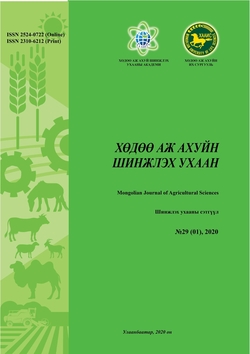Evaluation of septoria (Septoria nodorum) tolerance in wheat varieties
DOI:
https://doi.org/10.5564/mjas.v29i1.1376Keywords:
AUDPC, disease resistant, varieties, septoriaAbstract
Septoria tritici blotch (STB) caused by the ascomycete fungus Mycosphaerella graminicola (anamorph S. tritici) is currently one of the most serious foliar disease of wheat in Mongolia and other world regions characterized by temperate and wet environment during growing season. Fifty-one wheat genotypes with different resistance levels were evaluated in natural conditions for their reaction to S. tritici attack during 2017-2019 year. The experimental design was a randomized block design with two replications. Disease rating was visually recorded by using the scale (0-9) in two different times and crop stages (Z53-1/4 head out and Z70-milk development). There were also calculated the Septoria Progress Coefficient (SPC) and Area under Disease Progress Curve (AUDPC) for each wheat genotype evaluated. SPC was low for the higher genotypes comparatively with the shortest ones leading to the conclusion that disease progress is higher as plant height is low (r=-0.96**). The same aspect was also emphasized by the waek correlation between plants height and disease progress height (r=0.28**).The shortest genotypes showed higher necrosis percentage and AUDPC values. There was also a correspondence between genotype susceptibility and AUDPC showing that the most susceptible wheat cultivars recorded higher AUDPC values. The highest AUDPC values while Darkhan-201 (131), Darkhan-218 (163) and Omskau-36 (82) had the best resistance reaction to S. tritici attack.
Зусах буудайн сортуудад септориоз (Septoria nodorum) өвчний тэсвэрлэлтийг үнэлсэн дүн
Сүүлийн үеийн газар тариалангийн менежмент болон практик арга нь ээлжлэн тариалалтын сэлгээг баримтлахгүй жил дараалан үр тарианы ургамлыг тариалах болсон зэрэг нь навчны өвчлөл болон түрүүний өвчлөл ихсэх зүй тогтол ажиглагдаж байна. Талбайн нөхцөлд нийт 51 сортод септориоз өвчин тэсвэрлэлтийн үнэлгээг ерөнхий мөрддөг 0-9 баллаар буудайн түрүүлэлтээс, сүүн болц хүртлэх хугаанд ажиглалт хэмжилт хийсэн. Септориозийн тархалтын коэффициент (SPC), өвчний тархалтын муруй (AUDPC)-г тооцолсон. Септориоз өвчин тэсвэрээр Дархан-201, Дархан-217, Омская-36 сортууд тэсвэртэй ангилалд хамаарагдаж байна. Тэсвэртэй сортууд нь өртөмтгий сортууд өвчлөлийн хувьд 81.0-737.7 хэлбэлзэл ихтэй нь сортуудын хооронд ялгаа их байгааг өвчний тархалтын муруй нь (AUDPC) –ийн утга харуулж байна. Өвчний тархалтын муруй (AUDPC) нь ургамлын өндөр болон өвчлөлтийн өндрийн хязгаар (r=-0.78**) сөрөг хамааралтай. Харин өвчний тархалтын хувь нь септориозийн тархалтын коэффициент (r=0.789**), өвчлөлтийн өндрийн хязгаартай (r=0.651**) нягт хамааралтай байна. Септориоз өвчний хор хөнөөлийн коэффициентыг гаргахад ургацыг 22.4-67.2%-иар бууруулаж байна. Септориоз өвчний халдвар ихсэх тусам ургацын бууралт нэмэгдэх зүй тогтол ажиглагдаж байна.
Түлхүүр үг: AUDPC, септориоз, өвчин тэсвэрлэлт, сорт
Downloads
1274
Downloads
Published
How to Cite
Issue
Section
License
Copyright on any research article in the Mongolian Journal of Agricultural Sciences is retained by the author(s).
The authors grant the Mongolian Journal of Agricultural Sciences a license to publish the article and identify itself as the original publisher.

Articles in the Mongolian Journal of Agricultural Sciences are Open Access articles published under a Creative Commons Attribution 4.0 International License CC BY.
This license permits use, distribution and reproduction in any medium, provided the original work is properly cited.




